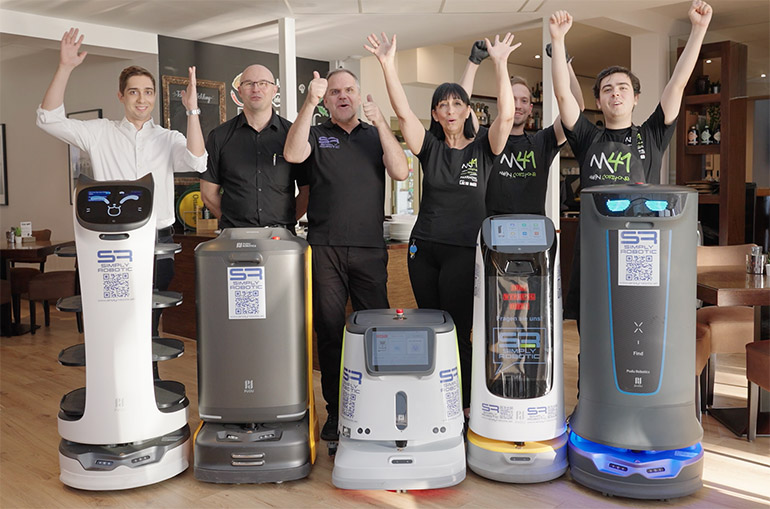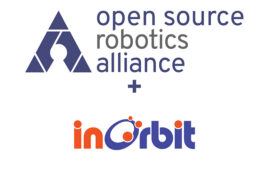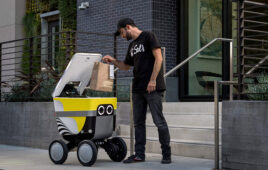|
Listen to this article
|

Parkhotel employees in Eisenstadt, Austria, celebrate the arrival of service robots. Source: Pudu Robotics
Commercial service robots are more common in East Asia than elsewhere, but the rest of the world could catch up in 2024, according to Pudu Technology Co. The Shenzhen, China-based company claimed that it is China’s top exporter of such robots.
“If 2023 was the year of GenAI, I believe 2024 will be the year of the robot,” stated Felix Zhang, founder and CEO of Pudu Robotics. “While humanoid robots and food-making robots grabbed headlines in 2023, the untold story is that it’s the humble service robot — robots that skillfully deliver items and clean floors, often in high-traffic areas — that are actually ready to scale in 2024.”
Last year, Pudu Robotics said it deployed robots across 600 cities in 60 countries. The company also partnered with SoftBank and Nippon Otis Elevators, opened its autonomous mobile robot (AMR) management platform to developers, and won Red Dot and iF Design awards. In addition, it raised more than $15 million in Series C3 funding.
Zhang discussed Pudu’s current offerings and his outlook for this year with The Robot Report:
Service robots to take on more healthcare roles
You have predicted more robots in hospitals and senior living facilities. Does Pudu offer robotics specifically for elder care?
Zhang: Pudu Robotics offers several robots that are deployed in senior living facilities to assist facility staff and residents in their day-to-day tasks and improve the emotional well-being of the elderly. The robots include the BellaBot and KettyBot, two models of delivery robots that can serve food or medicine, assist with returning items, and in some cases even interact with residents.
In addition, although it’s not designed to interact with residents, the PUDU CC1 cleaning robot can help keep senior living facilities tidy, as it is designed to scrub, sweep, vacuum and mop in care homes and other commercial settings. These capabilities automate menial tasks for overwhelmed workers and set the standard for hygiene in autonomous cleaning.
For example, a chain elderly care institution in Hong Kong, which operates 12 nursing homes with 1,600 beds, has adopted CC1 for cleaning the internal environment, reducing the workload of the staff.
PUDU’s robots are especially timely, as more than 1 in 6 Americans are now 65 years or older, and life expectancy continues to grow, thanks to medical advancements. Our aging population is contributing to a major healthcare staffing crisis.
The next 12 months will see the increased adoption of robots in healthcare, as short-staffed senior-living facilities employ the technology to complete tasks. They can monitor daily routines, provide reminders for medication schedules, detect changes in body temperature, and warn medical professionals and families of any abnormalities.
Robots can also provide emotional support for the elderly and robot-assisted living will become a crucial asset for the growing elderly population. Loneliness is a common problem for many older people, robots provide company and can engage in activities such as communication, storytelling, and playing music.
The traditional way of caring for the elderly often falls short of meeting all of their needs, and robots are able to fill the gaps.
Pudu addresses global markets, economic headwinds
How is the U.S. market for service robots growing in comparison with other regions?
Zhang: The global market for service robots is soaring, and the U.S. is beginning to catch up with its peers in Asia. According to the International Federation of Robotics [IFR], a non-profit industry association, sales of robots used in the service industry grew by 37% worldwide in 2022.
In 2024, the U.S. market is expected to generate the most revenue in the service robot industry, but regions like Japan are leading the way in development and adoption of the technology. In many developing countries, the service industry is hobbled by ever-mounting challenges in hiring workers.
In response, Pudu Robotics has engaged in a massive expansion beyond the borders of its home market since 2020, achieving rapid growth in shipments. Pudu leads the global market as China’s No. 1 service robot exporter, and cumulative global shipments are over 70,000 units.
In the U.S., employers facing staff shortages have turned to commercial service robots to provide relief for their remaining workers. Quick-service restaurants [QSRs], for example, expect 51% of tasks to be automated by 2025, while full-service restaurants expect to automate 27% of tasks. Service robots are automating menial tasks, improving overall efficiency, and preventing burnout among their human colleagues.
While the challenge of labor shortages is universal, how will robotics adoption overcome current economic headwinds?
Zhang: Currently, there are 4 million more open jobs than there are available workers in the U.S. to fill them. As society’s tolerance and acceptance of new technology grows, robots will plug this hole.
U.S. restaurants are a prime example. Owners face a “perfect storm” of an aging population, soaring child-care costs that shrink the pool of available workers, and a pandemic that pointed many workers towards more stable careers.
While economic headwinds may cause some delay, the world is still turning towards an increasingly automated future. Robots are the long-term solution for massive problems facing several industries.
Integration and AI to make robots more useful
From hospitality to healthcare and retail, which areas have the most demand? How much integration will be necessary?
Zhang: We’re seeing an increase in demand for service robots most from the restaurant industry, followed by hospitality, healthcare, and retail by order of demand increase. To meet that global demand, Pudu Robotics is building two new factories near Shanghai that will triple the company’s annual capacity.
Businesses across all four categories are finding it hard to maintain adequate service levels due to staffs being stretched thin. Integration will happen across these industries, as they all are dealing with the effects of the labor shortage. Business will still need human workers, but robots can supplement and improve efficiencies.
While large language models (LLMs) are improving human-machine interactions, how will they be instantiated in robots rather than on tablets and phones?
Zhang: Large language models can effectively enhance human-robot interaction, particularly in semantic understanding. Take, for instance, a robot serving as a shopping guide in a supermarket.
Previously, to find a specific brand of electric toothbrushes, customers needed to navigate through “personal care,” then “toothbrushes,” followed by “electric toothbrushes,” and finally the brand. With significant improvements in voice recognition and semantic understanding, it’s now possible to locate the item directly through a single command.
LLMs are highly beneficial for advancing end-to-end algorithms in modules such as positioning, navigation, and perception, significantly enhancing the efficiency of their evolution to achieve global optimization. Robots and LLM integration is already under way, but manufacturers need to ensure that the generated content aligns with human values and safety standards, while also ensuring that robots can reliably and responsibly interact with the real world.
In 2024, these models will be used effectively in robots — as well as tablets and phones — as robots with AI voice interactions and eye-catching displays make use of the advancing technology.
 Learn from Agility Robotics, Amazon, Disney, Teradyne and many more.
Learn from Agility Robotics, Amazon, Disney, Teradyne and many more.






Tell Us What You Think!